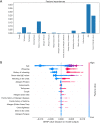The role of artificial intelligence in identifying asthma in pediatric inpatient setting
- PMID: 33313112
- PMCID: PMC7723595
- DOI: 10.21037/atm-20-2501a
The role of artificial intelligence in identifying asthma in pediatric inpatient setting
Abstract
Background: The incidence of asthma in Chinese children has rapidly increased as a result of inadequate management. This is mainly due to the failure of many primary-level pediatricians to distinguish asthma from common respiratory diseases, such as bronchitis and pneumonia. Such misdiagnoses often lead to the abuse of antibiotics and systemic glucocorticoids. Additionally, if asthma is not diagnosed early, chronic airway inflammation results in lesions that not only hamper children's athletic abilities, but serve as the primary cause for adult chronic airway diseases, such as chronic obstructive pulmonary disease (COPD).
Methods: A number of machine learning-based models including CatBoost, Logistic Regression, Naïve Bayes, and Support Vector Machines (SVM) have been developed to identify asthma via utilizing retrospective electronic medical records (EMRs) of patients. These models were evaluated independently using EMRs from both the Pulmonology Department and other departments of the Children's Hospital, Zhejiang University School of Medicine, China.
Results: Two independent test sets were applied for performance evaluation. TestSet-1 consisted of 325 positive asthma cases and 428 negative cases from the Pulmonology Department. TestSet-2 was composed of 2,123 cases from non-pulmonology departments, and included 337 positive and 1,786 negative cases. Experimental results showed that the CatBoost model outperformed other models on both test sets with an accuracy of 84.7% and an area under the curve (AUC) of 90.9% on TestSet-1, and an accuracy of 96.7% and an AUC of 98.1% on TestSet-2.
Conclusions: The artificial intelligence (AI) model could rapidly and accurately identify asthma in general medical wards of children, and may aid primary pediatricians in the correct diagnoses of asthma. It possesses great clinical value and practical significance in improving the control rate of asthma in children, optimizing medical resources, and limiting the abuse of antibiotics and systemic glucocorticoids.
Keywords: Pediatric; artificial intelligence (AI); asthma; diagnostic assistant; machine learning.
2020 Annals of Translational Medicine. All rights reserved.
Conflict of interest statement
Conflicts of Interest: All authors have completed the ICMJE uniform disclosure form (available at http://dx.doi.org/10.21037/atm-20-2501a). The authors have no conflicts of interest to declare.
Figures
References
-
- National Cooperative Group on Childhood Asthma. Institute of Environmental Health and Related Product Safety, Chinese Center for Disease Control and Prevention ; Chinese Center for Disease Control and Prevention. Third nationwide survey of childhood asthma in urban areas of China. Zhonghua Er Ke Za Zhi 2013;51:729-35. - PubMed
-
- Sha L, Liu C, Shao M, et al. Ten years comparison of diagnosis and treatment of asthma in urban children in China. Zhonghua Er Ke Za Zhi 2016;54:182-6. - PubMed
-
- Ye X, Xu C, Wang Z. Cognition of asthma guidelines among doctors in Jinhua city. Chinese J of Pub Health 2015;31:804-6.
LinkOut - more resources
Full Text Sources



